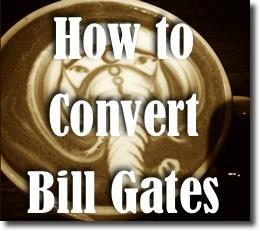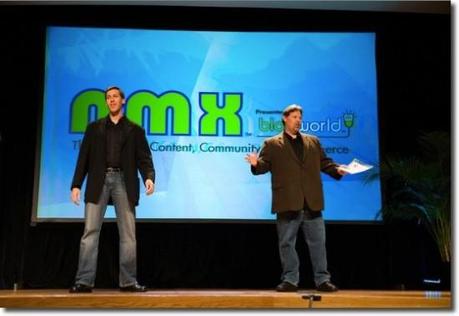 Imagine you walk into an elevator and boom! There’s Bill Gates.
Imagine you walk into an elevator and boom! There’s Bill Gates.
Your mind is on fire with thoughts like, “How much is he worth these days and how quickly could he get an audience with Obama?”
You smile at Bill and he briefly acknowledges your existence.
Now you think, “Showtime, baby! I’ve got ten seconds to engage him. And if I can get Bill’s tweet about my website or an invite to guest post on his foundation’s blog, I’m golden.”
You’ll need more than ten seconds to make something happen though. What you need are post-elevator pitch skills, because meaningful action happens after the pitch.
That’s not just me talking.
Seth Godin says,
“The best elevator pitch doesn’t pitch your project. It pitches the meeting about your project; it’s a little fractal of the entire story, something real.”
But your first challenge is to disarm Bill’s “not another crazy person trying to impress me” switch. And more importantly, you need to figure out how to get more than ten seconds with him.
Guess what? The elevator scenario strategy applies to your website too. After all, Bill’s more likely to spend ten seconds on your website than ten seconds in an elevator with you.
However, any website visitor could be a big-time influencer. So let’s quickly get past the elevator pitch to deepen the interaction and increase the odds for collaboration.
See Where They’re Going, Then Press a Button

“Look before you leap” is great advice for entering elevators, a business conference, or anywhere else.
It’s about the mindset of converting opportunity when it shows up.
Here’s what I’d say to Bill in the elevator:
“Oh, you’re heading to 19 too.”
Sure, I was actually going to the 28th floor, but I didn’t force an action before I saw where Bill was heading. Now we’re both going to 19 and I’m on the clock. My only goal is to get more than ten seconds out of Bill (same as it would be if he came to my website).
So I say, “Man. I wish more people wanted to collaborate on creating a simplified, organized, and money wise world.”
This is what my business is about, but I’ve framed this quick statement with almost universal human appeal. Bill might not care about simplifying and being money wise, but maybe he loves organizing. The key is that he has a few things to respond to – simplifying, organizing, and money – plus I’ve appealed to the natural need to collaborate.
My conversion strategy increases the chance Bill will say, “You know, my foundation is working on a method to simplify the distribution of a malaria treatment” (or the website equivalent of clicking your link).
You’ve got him interacting! You’ve maximized your moment and now it’s time to deepen the engagement.
This is the important part.
Even if Bill doesn’t take your preferred action (e.g. offering you a guest post or opting in to your email list), have some appealing secondary actions for him (e.g. other interesting topics or clicking on your “Start Here” page).
And with each potential action, you should be ready to quickly educate Bill on what’s in it for him. His attention costs a premium and he’s not going to like your Facebook page or check out your podcast unless he quickly understands the benefits.
Your action item: Refine your website elevator pitch (e.g. your tagline) with near-universal appeal and multiple chances to resonate.
Secure a Small Commitment

I was recently at New Media Expo (NMX) and got my elevator opportunity with its co-founder, Dave Cynkin.
I want to be a speaker at NMX next year and Dave has the magic wand to make that happen. But I didn’t lead with what I wanted. My leading words were, “So Dave, how can I help you simplify, organize, and be money wise?”
This had to be about Dave. The focus of our interaction needed to be beneficial to him.
After getting to know more about Dave, his world-champion martial artist kids, and that his son wants a shih tzu named “Gramps”, I gave him some options. I could work as a volunteer for the next NMX, he could think about extending me a speaker invite, or he could take me on a test run.
Dave told me NMX doesn’t use volunteers and hinted that I didn’t have the appropriate public speaking experience yet.
But he did offer me an upcoming challenge to prove myself.
I achieved my goal of meaningful interaction and – just as important – obtained permission to follow up. This initial interaction was crucial to forming a new relationship, just like converting a first-time website visitor into a subscriber can lead to big things down the road.
Your action item: Research the overlap between your goals and someone else’s needs to focus on them (not you).
Give Me Some “How”
Figuring out what to do and why is great, but sometimes you just need a dose of “how”.
Here are some steps to boost your appeal with the A-listers and improve your overall engagement:
- If you’re sick of guest posting: see how a pro like Gregory Ciotti grows his influence and partially eliminates the need for a pitch. His article at Think Traffic will help you interact with anyone from seemingly untouchable journalists to people who only want your best resources.
- Practice on your community: You’ll need to refine your message and engagement skills before you get the attention of a big shot. Why not practice on your friends, family, online community, or the people you already have the attention of? Rich Millington shows you the way in this inspiring ProBlogger piece about human psychology and building an indestructible group of fans (that may do the talking for you).
- Try it safely (and virtually) first: Think of a specific person and a specific five-second message you’d say if you actually met them. Then send that person a tweet with what you’d want them to hear if they landed on your website. This takes only a few minutes and can generate a response that gives you an opening for a follow-up. Try a different tweet a couple of months later if the first tweet gets no response (or one you don’t want). You can start fresh with your dream contact each time, do it from a safe distance, and engage them free from the fear of rejection.
Marketing Takeaway
Securing attention and getting a small commitment are the keys to the post-elevator interaction or website visit.
“Venture Philanthropy” @sifpnet helps social innovators get expertise and advice to make the world a better place. b-gat.es/SIuPpM
ó Bill Gates (@BillGates) October 9, 2012
You might need to tweak these steps for your personality and experience, but here’s what they could look like:
- Smile (with your web design and opt-in forms)
- Make a short statement appealing to broad human desires with multiple chances to resonate (via your tagline or branding)
- Present primary and secondary options for a response (like saying “hi” or clicking a link)
- Deepen the engagement by making it all about them
- Secure a small commitment
- Get permission to engage them again
- Recap why your next interaction will benefit them
Playing the post-elevator pitch right increases the chance your encounter turns into something amazing.
Bill Gates might not tweet you or ask you to guest post, but maybe he tells the next influencer he sees about your conversation. Whether that person’s name is Obama or someone else, that’s a big freakin’ deal.
Now it’s your turn.
How do you play the post-elevator pitch and apply the principles to your website?
Joel Zaslofsky
Joel Zaslofsky is an entrepreneur that gives instant access to download the free tools that he and thousands of others use to simplify, organize, and be money wise. When he’s not helping people do a Continuous Creation Challenge, enjoying nature, working on his online show Smart and Simple Matters, or chasing his son around the house, he’s cranking out useful stuff at Value of Simple to support the liberation of your time, money, and talent.
Photo Credit: Thomas Hawk, BlogWorld & TBEX

